
A longtime booster of biocontrols has received that industry’s highest award.
A longtime booster of biocontrols has received that industry’s highest award.
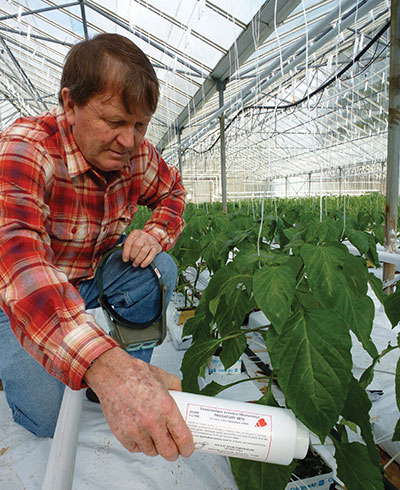 |
|
| Applying predatory mites. PHOTO COURTESY ANBP Advertisement
|
Don Elliott, founder and past-president of Applied Bio-nomics Ltd., is the newest Award of Excellence recipient of the Association of Natural Biocontrol Producers (ANBP).
Elliott is a past-president and long-term ANBP board member, and author of numerous books and articles relating to biological pest control.
“I set the award up in 2004, when I was ANBP president, but I never expected I would receive it myself.”
He presented the first award to Dr. Dave Gillespie, an entomologist with Agriculture Canada, who pioneered the development of biocontrol in greenhouses in British Columbia.
TRIBUTE TO 35-YEAR CAREER IN BIOCONTROL DEVELOPMENT
Elliott has been a leader and builder of the biological control community for over 35 years.
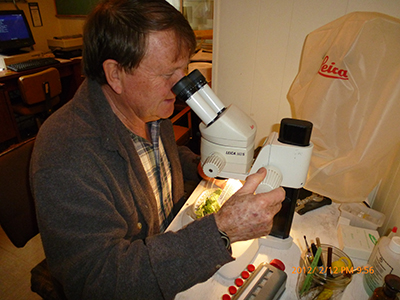
|
|
| Don Elliott checks bean leaves. PHOTO COURTESY DON ELLIOTT/APPLIED BIO-NOMICS |
He began his career as an employee with the provincial government in B.C., hired to work with and train B.C. Hothouse growers in the use of beneficial insects as replacements for chemical insecticides. He soon realized the industry needed a reliable supply of arthropods to meet the growing demand.
Agriculture Canada offered him some space at its research station in Saanichton, B.C., in 1978, and Applied Bio-nomics Ltd. was born.
The company quickly emerged as a leader in both education and production. It was the first to work with products such as Stratiolaelaps scimitus (ex-Hypoaspis miles), Delphastus catalinae, Stethorus punctillum, Deraeocorus brevis and Gaeolaelaps gillespiei, to name only a few.
Working
with Butchart Gardens and Crystal Gardens in Victoria, Elliott became a
leader in interior plantscape biological control. He was also the first
to pioneer the use of beans as a management tool for spider mite
control.
Elliott recently sold the company, but remains involved assisting with a number of research projects.
We recently interviewed him on his career in Q&A fashion.
What led to your interest in biologicals?
I attended the University of Alberta and majored in biology and education, graduating in 1972. I taught high school biology, science and outdoor education in Alberta and B.C. for a few years.
However, after moving to Victoria, I returned to work at insect related jobs at the Pacific Forest Research Centre and B.C. Ministry of Agriculture (BCMA). These involved working to find practical methods for biological control of the mountain pine beetle as well as methods for the biological control of greenhouse insects and mites. No biological control agents were commercially available in B.C. for these pests at this time.
How did Applied Bio-nomics come about? How modest was its launch, and how has it grown over the years?
Based
on the success of the (initial) demonstration program, I was encouraged
to continue and to set up a commercial biocontrol production facility.
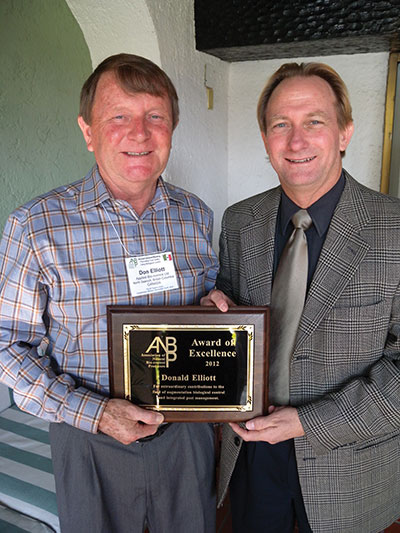 |
|
| Don Elliott receives ANBP’s Award of Excellence from Richard Ward of Biobest Canada. PHOTO COURTESY DON ELLIOTT/APPLIED BIO-NOMICS
|
You
notice that I am always using “we” when I describe the success of
greenhouse biocontrol. I was very fortunate to be in the right place at
the right time and to be able to be closely involved with many
forward-thinking growers, researchers and government specialists who
accelerated the process of getting biocontrol from research to
commercial application by providing the critical advice, resources and
funding when needed.
Normal bank funding was not possible. You should have seen the look on the bank manager’s face when I asked for funds to produce bugs!
We
were, however, able to obtain a $100,000 grant from the
federal/provincial ARDSA (Agricultural and Rural Development Subsidiary
Agreement) program. The funding would provide 100 per cent of the costs
in the first year, and decreasing portions over a five-year period.
Greenhouse
and laboratory space, along with research assistance, would continue to
be provided by Agriculture Canada. Entomology field training
specialists would be provided by the B.C. Ministry of Agriculture.
The
program was overseen by representatives from the B.C. Greenhouse
Growers Association, Ag Canada and the B.C. Ministry of Agriculture. The
biocontrol products produced would be sold to growers to help pay for
their production.
With this program in place, in 1980 we set up
Applied Bio-nomics Ltd. and purchased a house and five acres of
farm-zoned land near the research station.
Starting with one
small greenhouse, we gradually moved the operation from the research
station to our new property. At the end of the five-year grant period,
the company was fully self-supporting and the income from sales of the
biocontrol products paid for the salaries of myself and several other
research and production people as well as all other costs.
What were some of the first greenhouse biocontrols you worked with, and with what crops?
In
the 1970s, Canadian greenhouse cucumber and tomato vegetable growers
were starting to have serious crop damage from spider mites and
whiteflies and these pests were becoming resistant to pesticides and
conventional pest control strategies.
In B.C., entomologist Norm
Tonks at Agriculture Canada’s Saanichton Research Station had started
rearing and testing trials of two biological control agents, a spider
mite predatory mite, P. persimilis and a whitefly
parasite, Encarsia formosa. These were the first
biocontrols we worked with.
Most biocontrols take five to 10 years
to test commercial viability. Less than 50 per cent of the bios we have
tested were successful but gradually we developed a number of
commercial biocontrol agents for the first time:
- 1986 — Cucumeris thrips predatory mites and Aphidoletes aphid predators.
- 1987 — Hypoaspis thrips and fungus gnat predatory mites.
- 1989 — Aphidius aphid parasites.
- 1990 — Orius predatory bug thrips predator.
- 1993 — Deraeocoris predator.
- 1994 — Fallacis pesticide resistant predatory mite for field strawberry.
- 1994 — Delphastus whitefly predator and Degenerans predatory mite.
- 1995 — Stethorus spider mite predatory beetle.
- 2000 — Cotesia parasite and Dicyphus predatory bug production.
- 2002 — Atheta predatory beetle production.
- 2008 — Micromus predatory bug.
- 2010 — Gillespie predatory mite.
Were growers receptive to biocontrols from the beginning?
In
1978, and based on the positive results with biocontrols at the
Saanichton Research Station, provincial entomologist Jack Arrand helped
to secure funding for a two-year demonstration program to introduce B.C.
greenhouse vegetable growers to the benefits of biological control.
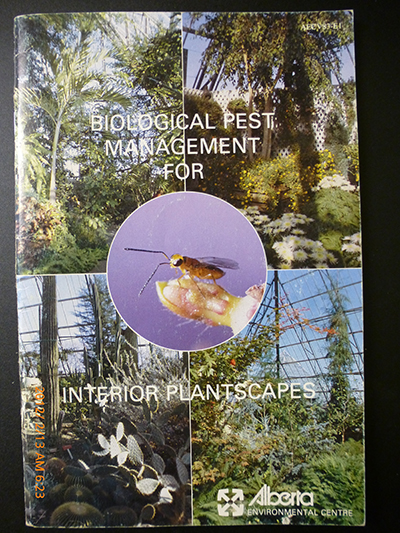 |
|
| Don Elliott co-authored this book with Marilyn Steiner of the Alberta Environmental Centre. Biological control “requires time, commitment and an understanding of the principles involved.” |
At
that point, I was hired for a two-year period to scale up the mass
rearing at Saanichton Research Station so we could conduct large-scale
grower demonstration trials.
Working with entomologist Bob
Costello, we conducted meetings with growers to promote the program. We
set up a greenhouse monitoring program and began introductions of
predatory mites and whitefly parasites at no cost to participating
growers.
Growers
were backed against a wall and were looking for any solution to solve
their pest problems. All we had to do was mass-produce enough parasites
and predators for trial commercial releases. Once we figured this out,
along with the appropriate release rates, the program sold
itself.
One of the first greenhouses we worked with was Ed
Lum’s greenhouses in Victoria. Uncontrollable spider mite infestations
had overwhelmed Ed’s cucumber crop every summer. In the spring, we began
to introduce Persimilis predatory mites and the results were tense but
amazing.
We were behind with the introductions, however, as spider
mites overwintering from the previous year were emerging everywhere. I
thought we had failed, as the infestations were getting worse.
Then
one week, when I was monitoring the crop, I found the predators were
everywhere, had eaten all the spider mites, and had moved outside onto
the spider mite infested blackberries. The crop recovered and there was
no mite re-infestation the following year!
We had similar results using the whitefly parasite, Encarsia. In many greenhouses, the whitefly infestations had been so bad that by summer, the growers had to wear face masks to stop from breathing and swallowing adult whitefly when working in the crop. We found that only four biweekly introductions of Encarsia into greenhouse tomato crops could establish the parasite and control whitefly for the entire season.
During this period, industry utilization of biocontrols increased from less than 20 per cent of growers in 1980 to over 85 per cent in 1985.
The first expansion from B.C. was into Alberta, where entomologist Marilyn Steiner helped develop methods of controlling thrips on cucumbers, showing increases in yields of up to 20 per cent using biocontrols. We also worked at that time with Marilyn and developed methods of biological control of pests in conservatories and interior plantscapes.
In 1989, Dave Gingrich and Roger Fisher, principals of two major greenhouse product supply companies, Westgro Sales and Plant Products, purchased shares in ABL and expanded the production and sales and use of biocontrols across Canada.
What greenhouse environmental and crop production factors have the greatest impact on the success of biocontrols? What suggestions would you have to help growers get the most out of their biocontrols?
Weekly monitoring of the crop is critical to determine both pest and biological levels. This is especially important with pests such as whitefly and thrips, where monitoring tools such as yellow sticky traps can detect these pests well before they are noticed on the plants.
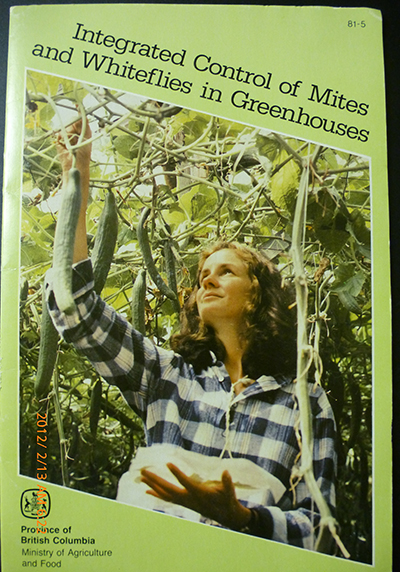 |
|
| Don Elliott worked with R.A. Costello of BCMAF on this key resource tool. Mites and whiteflies have long been major challenges for growers. |
This was proven in the spring of 1985, when BCMA entomologist Bob Costello mailed a few free sticky yellow traps to a number of greenhouse vegetable growers. The next week, growers who had previously not noticed whitefly or thrips, were calling to order biocontrols.
One of the positive signs that a grower is understanding biocontrol is when the question changes from, “what are the pest levels?” to “what are the biocontrol levels?”
Preventive introductions of biocontrols for whitefly, spider mite, aphids, thrips and fungus gnats are important.
This is now the standard and the most effective procedure as the bios will find the pest at very low densities and establish and control before the pest has a chance to build up. These are determined by monitoring and by predicting when pests such as spider mite will emerge from diapause.
Avoiding the use of pesticides as much as possible is also important as almost all pesticides have toxic residual effects of many weeks and often interfere with the biological control agents’ ability to find their hosts. The best and most cost-effective biocontrol program relies on reproduction of the biocontrol within the crop and this depends on low levels of the host pest.
Biological controls are living organisms and extremely perishable. Cold storage and shipping can seriously affect product viability, so this should be minimized and products should be used as soon as possible once received.
How did you use bean plants as a management tool for spider mite control?
If there were problems in a fall crop with spider mites, large numbers of overwintering spider mites diapause in the greenhouse structure and are certain to be present in the same greenhouses the following spring.
On crops such as cucumber and peppers, this can lead to a very difficult to control outbreak due to the high number of red spider mites leaving diapause and moving on to the crop over a short period of time.
Mass production of the spider mite predator Persimilis is done using bush bean plants, so it was a small step to suggest that growers having mite problems try planting beans in their planting bags, first thing in the year, before the pest mites arrived.
Bean plants are very attractive to spider mites, so when overwintering mites appear on the bean plants, the grower introduces the Persimilis predatory mite and the grower produces hundreds of thousands of their own predatory mites.
We convinced Sven Pederson at Cobble Hill Greenhouse on Vancouver Island to go one step further by introducing spider mites onto each bag of beans in his greenhouse several weeks in advance of the overwintering red spider mite influx. The result was spectacular!
There were huge numbers of predatory mites waiting for the red spider mites, and they not only easily controlled them, they eliminated all spider mites for two years. Expanding on this, for or a number of years we have sold spider mites on leaves to vegetable greenhouse growers in Holland and Canada to pre-inoculate plants and grow their own predatory mites.
What gave you the most satisfaction with your career?
The smiles of growers and co-workers! Greatly reduced pesticide use. Better pest control and higher crop yields. Successful development of Applied Bio-nomics biocontrol products. Exchanging biocontrol technology and ideas with co-workers in Canada, China, Australia, New Zealand, England, Holland and South Korea.
What are your plans for the future?
It was important for me to have ABL continue. Fortunately, Applied Bio-nomics had a great business manager, Brian Spencer, who had come to the company when we were struggling to survive and gradually improved its profitability over the years. Brian recently purchased all of the shares of ABL and is working to continue to expand the company in different areas.
I am continuing to work on contract as “research director” as well as to help solve ongoing production and operational problems.
| Research included in resource books Don Elliott shared some of his research in a number of industry publications.
|
Print this page